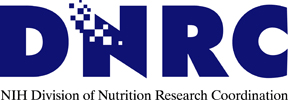
 |
National Institutes of Health (NIH) Bethesda, MD 20892 |
|
|
||||||||
| DNRC Home > Nutrition Education | ||||||||
DO YOU KNOW WHY YOU EAT?
Print version (PDF, 268 KB)This may sound like a simple question with a simple answer. Yet, for most of us, the answer is rather complex. Research suggests we make over 200 decisions about food each day. We eat not only to satisfy hunger but also in response to emotional and environmental stimuli or "triggers."
If you are trying to manage (lose or maintain) your weight and/or eat a healthier diet, it may be important to recognize why you eat. Although the discussion of food frequently focuses on selection, it is also valuable to understand your triggers. Knowing why you eat may help you to make more informed food choices.
Recognizing Triggers:
Each of us faces many environmental or emotional triggers every day, but most occur unnoticed. One of the best ways to become aware of your personal food triggers is to keep a food diary. Pick a day or several days and record what and when you eat as well as what else you are doing and feeling when you eat. Design your food diary to examine what you consider to be your triggers. Here are some sample questions:
- Were you eating in response to an emotion? If so, which emotion (e.g., stress, boredom, sadness, etc.)?
- Were you eating for a physical reason other than hunger (e.g., felt tired, or were having trouble concentrating)?
- Who were you with?
- Where were you?
- What else were you doing while you ate?
By keeping a food diary, you may notice environmental or emotional triggers that encourage you to eat when you are not hungry, such as:
- Sitting next to the refreshments at a staff meeting
- Seeing or smelling your favorite food
- Excess food on your plate
- Watching television
- A stressful day at work
- Feeling bored
Once you have identified your key triggers, you can plan how to respond BEFORE you are faced with the situation.
Environmental Triggers:
Environmental triggers include restaurant ads, food at meetings, and how you arrange food in your kitchen. Sometimes just becoming aware that you are being tempted by your surroundings can help you limit eating. When awareness alone doesn't work, the following suggestions may help you reduce temptation and exposure to triggers.
- Keep low-calorie snacks in your house or office instead of high-calorie selections; when tempting treats are not around, they are not so easy to eat.
- Restrict eating at home to the kitchen or dining room table.
- Keep serving dishes away from the table so you have to make the extra effort to get a second helping.
- Sit farther away from the refreshments at staff meetings.
- Ask the waiter not to bring the bread or chip basket to the table.
- Have the waiter bring a take-out container with your order so that you can split your meal in half.
- If you often snack when watching TV, occupy your hands with a craft project instead.
- Resist nibbling during food preparation. Instead, chew sugar-free gum or sip a calorie-free beverage.
Emotional Triggers:
Both positive and negative emotions serve as triggers to eat. For many cultures, eating is a big part of celebrations. While it is not necessary to forgo special occasions, one can practice moderation. Part of feeling in control of your food choices is reducing the association between emotion and food. For example, when feeling good about something, reward yourself with a non-edible treat instead of food.
When feeling sad, angry, or frustrated, you may also feel a desire to eat. People tend to eat for comfort or to distract themselves. Here are some alternative ways to cope with negative emotions:
- Go for a walk to get a change of scenery.
- Call a friend or write down what is bothering you.
- Sit down and relax; take five minutes to breathe deeply.
- Listen to music or read a book or magazine.
- Sip a cup of hot tea or take a hot bath.
For more techniques to effectively deal with emotional overeating, contact your doctor, counselor, or other health professional.
Eating for Health:
Understanding why you eat may help you to make better food choices. If your goal is to provide the healthiest fuel for your body, it is important to pay attention to your food selection.
The Dietary Guidelines for Americans provide advice about how to eat a well-balanced diet to promote health and reduce the risk for certain chronic diseases. The Guidelines describe a healthy eating plan that:
- Emphasizes fruits, vegetables, whole grains, and fat-free or low-fat milk and milk products;
- Includes lean meats, poultry, fish, beans, eggs, and nuts;
- Is low in saturated fats, trans fats, cholesterol, salt (sodium), and added sugars;
- Stays within your daily calorie needs .
For tips on controlling your weight, visit:
http://www.nhlbi.nih.gov/health/public/heart/obesity/lose_wt/control.htm
For information about the Dietary Guidelines for Americans and making smart choices, visit: http://www.health.gov/dietaryguidelines/dga2005/healthieryou/contents.htm.
For assistance in creating a personal eating plan that is right for you, visit:
http://www.MyPyramid.gov . Also, check out the DASH Eating Plan at http://www.nhlbi.nih.gov/health/public/heart/hbp/dash/new_dash.pdf .
DNRC Director: Dr. Van S. Hubbard ||
DNRC Home ||
Contact DNRC
The Division of Nutrition Research Coordination is part of the National
Institutes of Health, Bethesda, MD, USA.
Privacy
|| Disclaimer || Copyright
|| Credits || Accessibility
